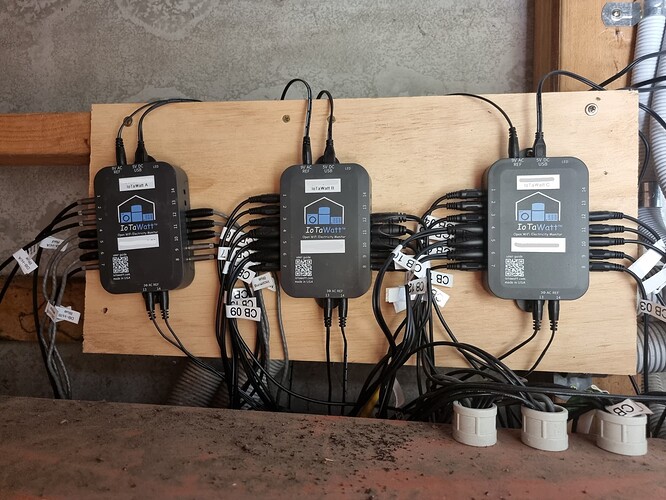So we use 4 of these units in our school to monitor building power usage and monitor voltage drop. We are in Australia so run at about 230V. Our school has 3 main distribution boards which each feed a number of buildings (we’ll call them A, B, C). Put very basically, power comes in the school into Board A, which feeds a number of buildings and also feeds Board B, which feeds a number of buildings and also feeds Board C, which feeds a number of buildings.
We decided to mainly monitor Board B using 3 IoTaWatt units. We monitor the 3 phases individually, with seperate VTs and CTs for the 3 incoming phases, the 3 phases going to every building and the feed going to Board C also.
After about 6 months of monitoring and some hot days, I’ve been checking to see our voltage drop across the school and checking if it’s within limits it’s supposed to be (from supply to any point in the school). Ideally I need to monitor the voltage near the supply at Board A to compare to (which we may do with another IoTaWatt unit eventually) but realised yesterday that I can calculate the voltage drop using a formula and in my multimeter tests so far, I can calculate what the supply voltage is at Board A using Amps or Watts & PF, the voltage and distance/cable size, I think I could do the same for Board C downstream also.
I’m now trying to enter that in as outputs in one IoTaWatt unit, but my issues are:
- The Units option seems to apply to all inputs used in the calculation, but not always. If I choose Watts and use a VT in the calc, it will use the voltage as the number, which is fine. If I choose Amps and use a VT in the calc, it will turn the voltage into a much smaller number (233v = about 0.21 Amps?). Ideally, I want to choose Volts as the Unit because I’m trying to calculate a voltage, but if I do that and use a CT in the calc, it turns the CT into the voltage number instead.
- I also can’t use PF in my calculations.
Ideally I’m trying to create this formula:
((Amps of incoming feed phase A * distance in metres * 2 * impedence of cable per km)/1000) + supply voltage phase A
My cable distance is 140m, impedence is 0.089 and assuming the incoming amps is 100 and voltage is 230, if I choose Volts as the Units, it will end up as:
((230 * 140 * 2 * 0.089)/1000)+230
Which isn’t right because the amps is expressed as a voltage instead. If I choose Amps as the Unit, it ends up as:
((100 * 140 * 2 * 0.089)/1000)+0.2
Which isn’t right because the voltage is changed to amps somehow. If I choose Watts, I have to use power factor with watts and voltage to work out amps, but I can’t use PF so I can only average it, but that means it’s not accurate.
((((22000w / 0.9pf) / 230) * 140 * 2 * 0.089)/1000) + 230
Also, using the Amps as a unit, I could almost convert the voltage to the same number by using:
voltage x 1000 - 223.5 x -1.11 + 223.5
Although it doesn’t match perfectly which means I can’t use it, but it’s close.
I know making changes can break existing calculations, but I’d love there to be a way to use different units of inputs in the one calculation. In my case, I need the output to be volts, and I want to use amps of an CT and voltage of a VT in the calculation together. Or if I use watts, I need the output to be volts and I need to use watts of a CT, PF of a CT and voltage of a VT in the calculation.
Am open to any thoughts or suggestions. I also know this may be asking too much and I could just export the data to excel but having an output for this would make it so easy to visualise for any date/time range.
Thanks
